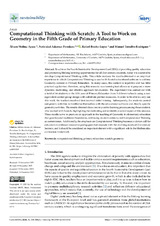Mostrar el registro sencillo del ítem
Computational thinking with scratch: a tool to work on geometry in the fifth grade of Primary Education
| dc.contributor.author | Molina-Ayuso, Álvaro | |
| dc.contributor.author | Adamuz Povedano, Natividad | |
| dc.contributor.author | Bracho López, Rafael | |
| dc.contributor.author | Torralbo-Rodríguez, Manuel | |
| dc.date.accessioned | 2024-01-16T10:19:56Z | |
| dc.date.available | 2024-01-16T10:19:56Z | |
| dc.date.issued | 2024 | |
| dc.identifier.issn | 2071-1050 | |
| dc.identifier.uri | http://hdl.handle.net/10396/26563 | |
| dc.description.abstract | To achieve the Fourth Sustainable Development Goal (SDG) of providing quality education and promoting lifelong learning opportunities for all 21st-century students, today it is essential to develop Computational Thinking skills. This article analyses the results obtained in an empirical experience in which Computational Thinking is used with Scratch educational software to address Geometry content in Primary Education. In many cases, this content is repetitive and has little practical application; therefore, using this resource as a learning tool allows us to propose a more dynamic, motivating, and effective approach for students. The experiment was carried out with a total of 66 students in the fifth year of Primary Education from 3 different schools using a non-equivalent control group design with substitute pre-test measures. In order to be able to carry out this work, the teachers involved first received initial training. Subsequently, the students carried out generic activities to familiarise themselves with the educational software and, finally, specific geometry activities. The results obtained show a more positive learning process among those students who worked with Scratch, highlighting the motivating and evidently practical aspect of this resource. These results serve to promote an approach to the teaching of Geometry in elementary education that goes beyond traditional boundaries, embracing student centricity and Computational Thinking as cornerstones. Additionally, the emphasis on Computational Thinking becomes a clarion call for educators to embrace innovative pedagogies that resonate with the evolving needs of 21st-century learners, and it should be considered an important element with a significant role in the Mathematics curriculum framework. | es_ES |
| dc.format.mimetype | application/pdf | es_ES |
| dc.language.iso | eng | es_ES |
| dc.publisher | MDPI | es_ES |
| dc.rights | https://creativecommons.org/licenses/by/4.0/ | es_ES |
| dc.source | Sustainability, 16 (1), 110 (2024) | es_ES |
| dc.subject | Computational thinking | es_ES |
| dc.subject | Primary education | es_ES |
| dc.subject | Scratch | es_ES |
| dc.subject | Geometry | es_ES |
| dc.title | Computational thinking with scratch: a tool to work on geometry in the fifth grade of Primary Education | es_ES |
| dc.type | info:eu-repo/semantics/doctoralThesis | es_ES |
| dc.relation.publisherversion | https://doi.org/10.3390/su16010110 | es_ES |
| dc.rights.accessRights | info:eu-repo/semantics/openAccess | es_ES |

